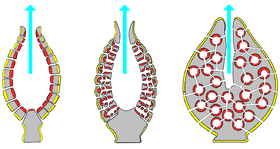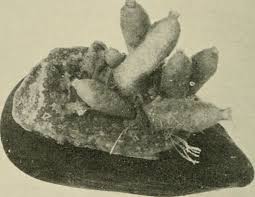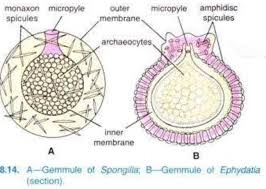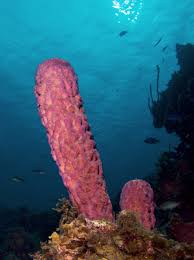Phylum- Porifera
Introduction:- About 5,000 species of sponges are known. Members of this phylum are commonly known as sponges. They are also known as ‘pore bearers’ as their body walls possess numerous tiny pores.
Phylum- Porifera
General Characteristic features:-
(1) Habitat:- All sponges are aquatic. Most of them are marine but a few sponges live in fresh water also. For example, Spongilla is a fresh water sponge. It is found in lakes and slow streams. Sponges are sessile organisms and remain attached to an underwater object, called substratum. They can not move about here and there. They obtained the food and other substances through the water entering their body.
(2) Body symmetry:– Sponges are the primitive multicellular animals. Most of them are asymmetric as any plane passed through their body center con not divide them into equal halves.
(3) Level of organization:- They have cellular level of organization. The cells in their body do not form the tissues. All cells act more or less independently and show little coordination. However, some division of labour is present among the cells.
(4) Body form:- It is the distinguishing feature of all the sponges. These numerous pores are meant for the entry and exit of water current. Minute pores present in the body wall through which the water enters into the body are called ostia (singular- ostium). These ostia lead into the single, central and spacious cavity called spongocoel or paragastric cavity either directly or through other small canals. The water entering through the ostia brings the food and oxygen inside the body of sponge. From spongocoel, this water exits outside through a large opening, the osculum.
(5) Body wall:- The body wall of a common sponge consists of following layers:-
(a) Pinacoderm (dermal layer):- It is outer cellular layer which consists of (i) flattened pinacocytes and (ii) oval porocytes.

(b) Choanoderm (gastral layer):- It is inner cellular layer which consists of highly specialized flagellated cells called choanocytes (collar cells). They are the characteristic cells of this phylum responsible for ingestion of food, secretion of mesophyl and differentiation of sex cells.
(c) Mesophyl layer (mesenchyme) :– Basically, it is a noncellular layer found between pinacoderm and choanoderm. It has fine dispersed spongin fibres and numerous spicules. It also contains many types of amoebocytes (amoeba-like cell) of both pinacoderm and choanoderm.
One of the amoebocytes is called archaeocytes, which may be converted into other types of cells and are also called undifferentiated “totipotent” cells.
(6) Canal System:- They body of a sponge is organized in such a manner as to form a complex system of pores and canals. This system is called canal system.

Function of canal system or water transport system:-
(i) Food gathering:- The food of sponges consists chiefly of plankton, i.e microscopic animals, plants and organic particles present in the water. The food is gathered with the help of canal system and after entering the body, food is captured by the choanocytes for digestion.
(ii) Respiratory exchange:– There are no special respiratory structures in the sponges so the exchenge of O2 of CO2 occurs through the water entering and going out with help of canal system.
(iii) Removal of waste:- The undigested residue and the metabolic waste ; chiefly ammonia (NH3), are eliminated out with the water through oscula (sing:- osculum).
(iv) Transfer of sperms:- Sperms from one sponge enter other sponge with the help of water and fertilise the egg in situ. Hence their transfer is facilitated by the water transport system.
(7) Digestion:- Sponges are the filter-feeders as the microvilli of collar cells filter the microscopic plants and animals from the water entering the body. These food particles are then taken up by the choanocytes for intracellular digestion (i.e food is digested inside the cells).
(8) Skeleton:- Almost all sponges possess an internal skeleton, also called the endoskeleton. This internal skeleton provides the support to the body of sponges and comprises of spicules or spongin fibres or both. Further the spicules may be calcareous (made up of calcium) or siliceous (made up of silica).
(9) Reproduction:- All sponges are hermaphrodite i.e sexes are not separate in them. Male gametes (sperms) and female gametes (ova) both are produced by the same individual. Hermaphrodite animals are also called monoecious and bisexual.

Types of reproduction in sponges:-
Both asexual and sexual reproduction occur in them. They reproduces asexually by fragmentation whereby the organism splits into the fragments. Each of these fragments develop into mature, fully grown individuals that are the clones of the original organism. Asexual reproduction also occurs by budding and gemmule formation.
Note:-
(i) In fresh water sponges a nd a few marine sponges, gemmules (internal buds) are formed. Each gemmule has a mass of archaeocytes surrounded by protective covering to tide over seasonal drought or adverse environmental conditions. Gemmule formation is often called internal budding.

(ii) Sponges have a great power of regeneration.
Sexual reproduction occurs by the formation of haploid male and female gametes. The sperms leave the body of the sponge and enter that of another with the water current to fertilise the ovum (egg) in situ. Hence the fertilization takes place inside the body of another sponge. This type of fertilization which involves sperms of one and ova of other individual is called cross fertilization and as the fertilization occurs within the body of sponge it means they undergo internal fertilization. It results in the formation of a diploid zygote.
(10) Development:- In sponges the development of adult sponge from diploid zygote is indirect which means it is mediated by by an intermediate free swimming flagellated larval stages (like amphiblastula and parenchymula) for dispersal of species. Larval stage is morphological distinct from adult.
Example of sponges:- Sycon (Scypha), Spongilla (Fresh water sponge) and Euspongia (Bath sponge), Leucosolenia, Sycon, Grantia.

Euplectella- the venus flower basket, Hyalonema-the glass rope sponge.
Euspongia- the bath sponge, its skeleton is made up only of sponging fibres. Spongilla the fresh water sponge, Cliona- the boring sponge. The larva of the sponge bores into the shells of mollusks and Chalina– “deadman’s fingers”